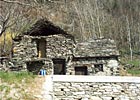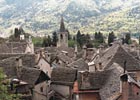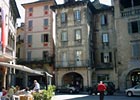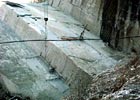|
|
| THE TERRITORY | History and culture |
 |
| |
|
The knowledge of stone materials for ornamental and building use is a documental basis of great cultural interest in order to point out the meaningful peculiarities of the development of a social environment such as the economic growth, the openness towards external contributions and the changing of tastes, trends and fashions as time goes by, through the development of the use of natural stones.
The culture of stone use in Italy is both an historical peculiarity proved by the greatest world concentration of monumental works, and a basis for the development of the ornamental materials industrial and craftmade sector, in which our Country is the world leader.
|
 |
| A quarry cutting |
|

 |
| Ancient stone houses |
 |
| Craveggia |
|
The Ossola district plays a unique role in the Italian territory, since it is the main basin of the extractive industry for beola and serizzo, ortogneiss, derived from Alps metamorphic (315-270 Ma) both on the Italian and the foreign market. In Ossola there are also different marble quarries such as the famous "Candoglia marble" used to build the Milan Cathedral, and at the beginning of the valley it is possible to extract "I graniti dei laghi" such as Baveno and Montorfano.
Milan is the city that better represents the use of the Ossola stones and in it there are the various materials used throughout the different periods, but also Turin, Genoa, Venice, Rome and Naples are examples of the use of materials from the Ossola valley.
Up to the nineteenth century Ossola was still an half-closed economy area, a little closed world with its own measures, its own local habits, its own particular dialect, its hand-made clothes, its production was only sufficient to meet the internal wants .Every village had its own craftsmen with their little activities , together with a universe of small holders whose only activity was to feed the cattle and to pick their crops.
|

|
Today industry, commerce and tourism are the most important activities of the Ossola valley economy and the stone plays a more and more important role in the whole valley life, in this new environment.
While in other rural communities the most part of the structures are made in wood, in Ossola they are made in stone. In some villages of the high valley everything is made in stone: houses roves and walling, tools, furniture, streets and borders marked by fixed marble adjacent slabs, the vines supports, placed at the right hight in order to allow the cultivation of the fields and household objects such has stoves, the "furnet" to heat the house.
|
 |
| Domodossola |
|

 |
the Milan port
of discharge
lithography of
the nineteenth
century |
|
In Ossola there are several ornamental stone quarries and most of them are still active; only at the beginning of the nineteenth century. they have been started being exploited continuously, even if the oldest act witnessed goes back to 19th October 1387, when the duke Gian Galeazzo Visconti owner of the Lake Maggiore lands, authorized the extraction of Candoglia Marble in order to build the Milan Cathedral and ordered to the local authorities to allow the transport through waterways without duties, tolls and taxes.
Till the end of the last century the marble blocks were sized according to the required measures and loaded on long boards that from the Toce river arrived to the Lake Maggiore, then to the Ticino river and in the end to the Canal.
|

|
Nowadays the Candoglia marble is out of sale because the "Veneranda Fabbrica del Duomo di Milano" is the owner of the quarries and the materials were used only to build and are used only to maintain the Milan Cathedral.
|
 |
| Gray Beola |
|
|




